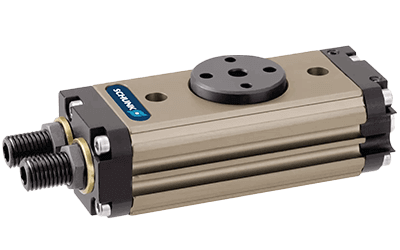What Is a Rotary Actuator?

A Rotary Actuator is a type of actuator that converts compressed air pressure or hydraulic pressure into rotary motion.
Compared to linear actuators, rotary actuators can be used in a smaller space, and especially when hydraulic pressure is used, they can be driven with high torque. Types of Rotary Actuator include the rack and pinion type, which uses straight gears and circular gears; the Scotch yoke type, which uses a shaft, spring, and rotating shaft; and the vane type, which uses a shaft and vanes inside a circular chamber.
Like air cylinders, these actuators generate rotational force by compressed air and are used in production.
Rotary Actuator Applications
Rotary Actuators are used to drive all kinds of machinery in steel, construction, and production plants. Actual applications include agitating, positioning, pulling, lifting, opening, and closing.
Examples of Rotary Actuator applications include:
- Lifting and rotating movements in automated lifts.
- Opening and closing hatches and operating valves in submarines.
- Positioning of drills in mining equipment.
- Actuating crane swivels, doors, and hatches.
Depending on the application, torque, speed, durability against vibration and heat, and size should be considered in the selection process.
Principle of Rotary Actuator
Rotary Actuators are generally powered by pneumatic, hydraulic, or electric power. Depending on the type, various mechanisms are utilized to convert compressed air (air), hydraulic pressure from piping, or electric power into mechanical rotary motion.
For example, in the case of pneumatic actuators, the vane type sends compressed air into a space inside the actuator body called a chamber, and the compressed air pushes a partition in the space called a vane to generate torque that turns a connected output rotary shaft. In the rack and pinion type, a cylinder piston operated by compressed air turns a linear gear, and that force operates the output rotary shaft connected to the circular gear.
For hydraulics, the Scotch-yoke type, which consists of a piston and rotating shaft, is often used. In the case of electric power, brushless motors and various other motors are used to provide output rotational force for Rotary Actuators.
In general, it is easier to obtain rotary torque forces in the following order: pneumatic, electric, and hydraulic. However, hydraulics in particular require piping facilities, pumps, and various oil-related maintenance, and are less energy efficient. Some manufacturers are even offering hybrid rotary actuators that combine the best aspects of both hydraulic and electric power.
Types of Rotary Actuators
1. Rack and Pinion Type
The rack and pinion type consists of a straight gear called a rack, a circular gear called a pinion, a piston operated by compressed air, and chambers on both sides of the piston. The chambers are filled with compressed air, which pushes the piston, causing the linear gear to operate in conjunction with the piston and the circular gear to rotate.
This rotation causes the mechanism to function as an actuator that performs rotary motion. Structurally, it has high sealing performance and relatively little air leakage, but its complicated structure and high cost are its disadvantages.
2. Scotch-Yoke Type
The Scotch-yoke type, mainly used in hydraulic applications, consists of a piston, spring, and rotating shaft. Hydraulic pressure causes the piston to move up and down, and the rotary shaft converts this motion into rotary motion to function as a Rotary Actuator.
3. Vane Type
The vane type has a chamber in a circular shaft to which the vanes are connected. The chamber has two spaces with vanes, and by filling one side with compressed air, the shaft moves in a rotary direction and is converted into a rotary motion.
A chamber with one vane is called a single vane, while a chamber with two vanes is called a double vane. The double vane has a limited oscillation angle, but can provide twice the rotational torque of a single vane.